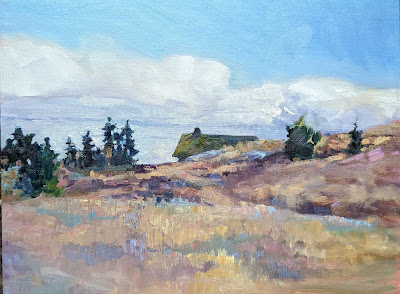Beautiful brushwork rests on a foundation of good preparation.
 |
| Ravening Wolves, 24X30, is in my show, Fantastic Places and Magical Realms at the Camden Public Library, month of December. |
I recently came across the sketch below, of two wolves. I was surprised and pleased, because it’s something I drew about a decade or so. It became the subject of a painting I finished Friday, called Ravening Wolves, above. (You can see the whole show in the video here.)
| The sketch for Ravening Wolves was much older, and was based on a personal crisis. |
Stop thinking of drawing as something you have to get through, and start doing your dreaming in a sketchbook. You never know when you’ll use the images thus created.
“Painterly” describes a painting that is comfortable in its own skin. The paint creates movement and expression. Painterly works are loose and emotive, and they lead with their brushwork.
This is a sensual, rather than intellectual, quality. You’re there when you no longer fight the paint, but work with it. It’s the opposite of photorealism, where the artist works hard to conceal all evidence of his process. A painterly painting doesn’t fuss over the details.
 |
| Christmas Eve, 6X8, is a memory of driving home from my grandmother’s house in deep snow. |
The term “painterly” was coined in the 20th century by art historian Heinrich Wölfflin. He was trying to create an objective system for classifying styles of art in an age of raging Expressionism. The opposite of painterly, he felt, was “linear,” by which he meant paintings that relied on the illusion of three-dimensional space. To him this meant using skillful drawing, shading, and carefully-thought-out color. Linear was academic, and painterly meant impulsive.
That didn’t make the Old Masters inevitably linear, however. Rembrandt and Lucian Freud are both painterly painters. Richard Estes and Sandro Botticelli are both linear.
Today, we don’t see accurate drawing as an impediment to expression. Acute drawing is often overlaid with expressive brushwork. The idea of painterliness—of being loose and self-assured—is treasured even as we strive for accuracy.
 |
| The Hunter and the Hare started life as a demo. It ended up being a portrait of our midnight race to leave Patagonia. |
How do we develop painterliness?
First, master the fundamentals. “You can practice shooting eight hours a day, but if your technique is wrong, then all you become is very good at shooting the wrong way,” said basketball great Michael Jordan. “Get the fundamentals down and the level of everything you do will rise,” he said. That’s very true of painting, where there is a specific protocol for putting paint down.
Then practice, practice, practice. “I’m not out there sweating for three hours every day just to find out what it feels like to sweat,” said Jordan.
Expect failure. It comes with pushing your technique. “I have missed more than 9,000 shots in my career. I have lost almost 300 games,” said Jordan. “On 26 occasions I have been entrusted to take the game winning shot… and missed. And I have failed over and over and over again in my life. And that is why I succeed.”
You can’t teach yourself to be relaxed; you can only get there through experience. The only way to be painterly is to paint. I can show you expressive brushwork techniques, but there are still no shortcuts. It happens automatically and naturally with experience. You stop focusing on the mechanics, and start focusing on what you see. Your eye is on the ball.
Many times, artists only realize their painterliness in old age. That is when Titian started painting in blotches, in a style that came to be known as spezzatura, or fragmenting. However, Vincent Van Gogh is the personification of painterliness, and he died at 37.
Great painters all end up doing their work in a specific way:
- They figure out a composition based on line, form, and value masses;
- They transfer that to their paper or canvas;
- They paint colors in a predetermined order, established with the invention of their medium.
In oils that protocol is:
- Fat over lean;
- Dark to light;
- Big shapes to smaller shapes.
In watercolor, the order of operations is:
- Washes to detail;
- Dark over light (not written in stone).
Practice until you get it perfect.


































